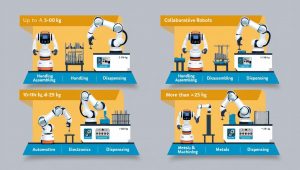The U.S. collaborative robotics market is at the precipice of a major transformation, with an increasing number of businesses integrating collaborative robots (cobots) into their operations to boost productivity, enhance safety, and reduce costs. Unlike traditional industrial robots, cobots are designed to work alongside human operators, enabling a seamless blend of human intelligence and robotic precision. This collaborative approach is set to redefine the future of manufacturing, warehousing, logistics, and several other sectors in the U.S. as companies strive to meet the demands of the ever-evolving business landscape.

The Rise of Collaborative Robotics in the U.S.
Over the past decade, there has been a surge in automation adoption, with companies embracing robotic technologies to enhance their manufacturing processes. However, the introduction of collaborative robots has added a new dimension to this trend. Cobots are unique because they are specifically designed to work in close proximity to humans, performing tasks such as assembly, packaging, inspection, and material handling, all while ensuring the safety of human workers. This level of interaction allows businesses to leverage the strengths of both human labor and robotics, enhancing efficiency and improving operational flexibility.
The growth of collaborative robotics is being driven by several factors:
-
Increased Demand for Flexibility: Unlike traditional robots that are often confined to dedicated, enclosed areas, cobots can work in a more flexible environment, adapting to different tasks without the need for expensive modifications. This makes them ideal for small and medium-sized enterprises (SMEs) that need agile solutions for changing production requirements.
-
Worker Safety and Ergonomics: One of the biggest advantages of cobots is their ability to work directly with humans without posing significant safety risks. They are equipped with advanced sensors, force-limiting technology, and intelligent algorithms to ensure they stop or slow down if they detect any potential collision with a human. This significantly reduces the risk of accidents and enhances worker safety, a key consideration in industries like automotive, electronics, and pharmaceuticals.
-
Cost Efficiency: Traditionally, industrial robots required large upfront investments and significant infrastructure changes. Cobots, on the other hand, are more affordable and easier to deploy. They can be integrated into existing production lines, making automation accessible to smaller businesses and allowing for a faster return on investment.
-
Advancements in AI and Machine Learning: The increasing sophistication of artificial intelligence (AI) and machine learning (ML) algorithms has played a critical role in making collaborative robots smarter. These robots can now adapt to varying tasks, learn from their environment, and optimize performance in real-time, which makes them even more effective in dynamic manufacturing settings.
Download PDF Brochure @
https://www.marketsandmarkets.com/pdfdownloadNew.asp?id=194541294
Industries Leading the Adoption of Cobots
Several industries in the U.S. are witnessing a rapid adoption of collaborative robotics, driven by the need for automation, efficiency, and workforce optimization:
-
Manufacturing: The manufacturing industry, particularly in sectors such as automotive, electronics, and consumer goods, has been at the forefront of adopting cobots. Cobots can perform repetitive tasks such as assembly, packaging, and quality control with high precision, reducing human error and improving production throughput. Their flexibility also allows for quick reconfiguration in production lines, accommodating various product designs and manufacturing processes.
-
Logistics and Warehousing: In the logistics sector, cobots are being deployed to assist with material handling, sorting, and packaging. By automating these processes, companies can reduce the risk of injuries from manual labor, optimize storage space, and speed up order fulfillment. With e-commerce booming in the U.S., the demand for automation in warehouses is expected to continue to rise.
-
Healthcare: In the healthcare sector, cobots are used for tasks such as surgical assistance, medication dispensing, and cleaning. Cobots equipped with advanced sensors and AI capabilities can assist medical professionals in performing complex procedures with higher precision, ultimately improving patient outcomes and streamlining healthcare operations.
-
Consumer Goods and Electronics: The consumer goods and electronics industries are also adopting cobots to manage high-volume production and handle delicate components. The ease of integration into existing production lines allows these sectors to remain agile and competitive while maintaining product quality.
-
Food and Beverage: Cobots are becoming increasingly popular in the food and beverage industry, where they are used for tasks like food sorting, packaging, and quality inspection. These robots can handle food products with care, improving efficiency in areas where hygiene and speed are critical.

Future Outlook: The Road Ahead for U.S. Collaborative Robotics
The future of the U.S. collaborative robotics market looks promising, with continuous advancements in technology paving the way for even more sophisticated robots. According to experts, the integration of AI and machine learning will allow cobots to become even more autonomous, capable of taking on a wider range of tasks across industries.
Key trends to watch out for in the coming years include:
-
Increased Customization: As cobot technology becomes more advanced, there will be a growing focus on customizing robots to meet the specific needs of different industries. Manufacturers will be able to program cobots to handle a wide variety of tasks, making them more versatile and adaptable to complex operations.
-
Human-Robot Collaboration: The future of collaborative robotics will see an even closer relationship between humans and robots. Rather than simply replacing human workers, cobots will serve as valuable co-workers, helping employees with tasks that are too repetitive, dangerous, or physically taxing.
-
Integration with Other Technologies: The future will also see greater integration of collaborative robots with other technologies such as the Internet of Things (IoT), cloud computing, and big data. This will allow for real-time monitoring, predictive maintenance, and continuous optimization of processes, leading to higher efficiency and lower operational costs.
-
Expanding Adoption in SMEs: As the cost of cobot technology continues to decrease, small and medium-sized businesses (SMEs) will increasingly turn to collaborative robots as an affordable solution for automation. This will help democratize access to advanced robotics and empower a broader range of companies to boost their productivity and competitiveness.
The U.S. collaborative robotics market is poised for significant growth, driven by technological innovations, advancements in AI, and the growing need for automation across industries. As cobots become more affordable, adaptable, and efficient, they will continue to transform how businesses operate, enabling greater collaboration between human workers and robots. Whether it’s in manufacturing, logistics, healthcare, or consumer goods, collaborative robots are set to revolutionize industries and drive the next wave of automation in the U.S.
Frequently asked questions (FAQs) :
1. What are collaborative robots (cobots)?
Collaborative robots, or cobots, are designed to work alongside human workers in a shared workspace. Unlike traditional industrial robots, cobots are equipped with safety features like sensors and force-limiting technology, allowing them to operate safely in proximity to humans without the need for protective barriers.
2. Why are collaborative robots becoming popular in the U.S.?
Collaborative robots are gaining popularity due to their flexibility, cost-effectiveness, and the ability to improve safety in workplaces. They enable companies to automate tasks like assembly, packaging, and quality control while working alongside human workers. This reduces labor costs and increases productivity, making them a practical solution for small and medium-sized enterprises (SMEs) as well.
3. Which industries are adopting collaborative robots?
Several industries are adopting cobots, including manufacturing (automotive, electronics, and consumer goods), logistics and warehousing, healthcare, food and beverage, and more. Cobots are used in tasks such as material handling, assembly, quality inspection, packaging, and even surgical assistance in healthcare.
4. What are the benefits of using collaborative robots in manufacturing?
Cobots improve efficiency by automating repetitive tasks, reducing human error, and enhancing production speed. They also ensure worker safety by preventing accidents and injuries, making them a valuable tool for industries looking to boost operational efficiency. Additionally, they can be easily integrated into existing production lines, reducing downtime and the need for costly infrastructure changes.
